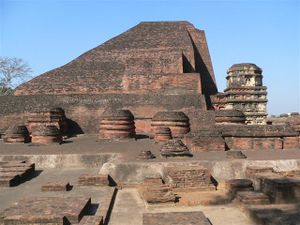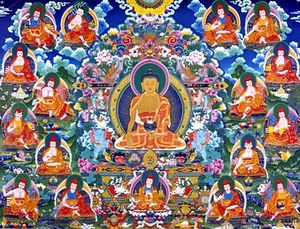Nalanda University: Difference between revisions
No edit summary |
No edit summary |
||
| Line 25: | Line 25: | ||
==Further Reading== | ==Further Reading== | ||
*George Roerich, ''Biography of Dharmasvāmin (Chag lo tsa-ba Chos-rje dpal)'', Patna: K.P Jayaswal Research Institute, 1959 | |||
*Steven Darain, 'Buddhism in Bihar from the 8th to the 12th Century with Special Reference to Nâlandâ' in ''Asiatische Studien'' 25 (1971) pages 335-352 | *Steven Darain, 'Buddhism in Bihar from the 8th to the 12th Century with Special Reference to Nâlandâ' in ''Asiatische Studien'' 25 (1971) pages 335-352 | ||
Revision as of 15:18, 5 November 2010

Nalanda (Skt. Nālandā) - Even a modern visitor to the ruins of Nalanda University cannot fail to appreciate the magnificence of this ancient place of learning. At its pinnacle as many as 10,000 monks lived and studied at this site. The list of its famous students and teachers reads as a who's who of Buddhism's greatest thinkers: Nagarjuna, Aryadeva, Shantideva, Asanga, Vasubandhu, Padmasambhava himself—just to name a few—all studied and/or taught at Nalanda. (See Seventeen Nalanda Masters)
History
Located on the site of a mango grove where Buddha himself often visited, the university's date of origin is not known for certain, although some historians now think it dates to the time of Ashoka in the fourth century BC. What is known is that for at least one thousand years, until its destruction by Mogul invaders around 1200 AD, it was the most important place of learning of the ancient world, not only for Hinayana and Mahayana philosophy but medicine, logic, astrology, and many other subjects as well.
The lecture halls cover many acres of land lined up along a long road that divides the teaching area from the adjoining temples. Along the edge of each lecture hall were rooms for the monks and their teachers. What remains is for the most part no more than several meters high, but the plan of the monasteries is still clearly in evidence.
One of the most prominent features of the Nalanda University ruins is the stupa built in honor of Shariputra, who, by tradition, was born and also died in the area. Jetsun Taranatha explains that Nalanda is the place where Shariputra was born and attained arhathood. According to a prophecy the Mahayana teachings would spread greatly if they were taught at the place of Shariputra, but if taught at the place of Maudgalyayana although the Buddhists would be very powerful, the teachings would not spread as widely. Ashoka was the founder of the first monastery in Nalenda.
The great library of Nalanda University was so vast that it is reported to have burned for three months after the Moguls set fire to it, sacked and destroyed the monasteries, and drove the monks from the site.
Location
Located near "Vulture's Peak" (not far from Rajagriha) in Bihar Province of India, it can be reached by a few hours drive from Bodhgaya, the historic pilgrimage site where the Buddha attained enlightenment.
Legacy

His Holiness the Dalai Lama rarely starts a teaching without mentioning that it is in the "great tradition of Nalanda University".
Gallery
Further Reading
- George Roerich, Biography of Dharmasvāmin (Chag lo tsa-ba Chos-rje dpal), Patna: K.P Jayaswal Research Institute, 1959
- Steven Darain, 'Buddhism in Bihar from the 8th to the 12th Century with Special Reference to Nâlandâ' in Asiatische Studien 25 (1971) pages 335-352



